Bulletin – March 2010 The Australian Government Guarantee Scheme
- Download the article 193KB
Abstract
The Australian Government Guarantee Scheme for Large Deposits and Wholesale Funding (the Guarantee Scheme) was announced in October 2008 amid extraordinary developments in the global financial system. Given that funding conditions have subsequently improved significantly, and that a number of similar schemes in other countries have closed, the Australian Government has announced that the Guarantee Scheme will also close to new borrowing from 31 March 2010.
Introduction
The Australian Government Guarantee Scheme for Large Deposits and Wholesale Funding (the Guarantee Scheme) was announced in October 2008 in response to extremely difficult conditions in the global financial system, and similar announcements in a number of other countries. The arrangements promoted financial system stability in Australia, and the ongoing provision of credit, by supporting confidence and assisting authorised deposit-taking institutions (ADIs) to access funding at reasonable cost at a time of considerable turbulence. They also ensured that Australian institutions were not placed at a disadvantage compared with their international competitors that could access similar government guarantees on bank debt.
Given the improvement in funding conditions, however, and the recent or imminent closure of wholesale funding guarantee schemes in a number of countries, the Government has announced that the Guarantee Scheme will close to new liabilities on 31 March 2010. The Reserve Bank has been involved in these arrangements as the Administrator of the Guarantee Scheme and, together with other agencies on the Council of Financial Regulators, in an advisory role on its design and operation. This article looks at the events leading to the introduction of the Guarantee Scheme, its main features, how it was used and the developments enabling its closure.
The Introduction of the Guarantee Scheme
In the latter part of 2008, international developments led to extreme pressure on the availability and cost of funding for banks around the world. In September 2008, the collapse of Lehman Brothers triggered high uncertainty about the stability of the global financial system, and a virtual closure of parts of global capital markets. The perceived risk of large banks across the world, as reflected in credit default swap (CDS) premiums, rose to unprecedented levels (Graph 1) and international long-term wholesale funding markets had essentially closed to non-sovereign borrowers. Despite their ongoing strong capitalisation, earnings and asset quality, Australian ADIs were affected by these developments, with reluctance among investors to buy long-term bank debt, and signs of nervousness among some depositors.
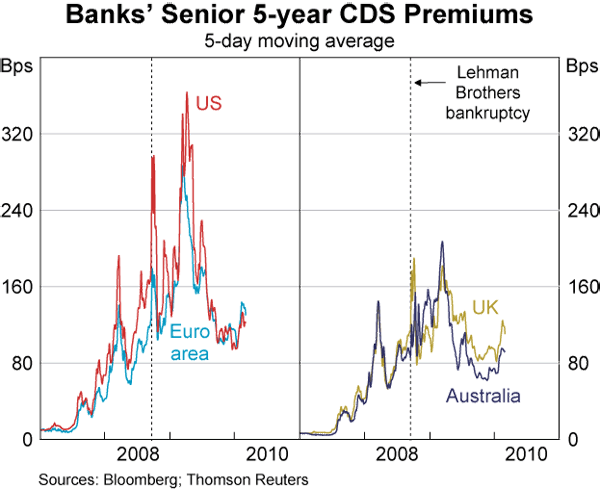
Against this backdrop, governments in a number of countries announced the strengthening of deposit protection arrangements and the provision of guarantees for financial institutions' wholesale debt. On 12 October 2008, the Australian Government also moved to reassure investors and depositors in Australian ADIs, and to ensure that Australian ADIs were not disadvantaged compared with banks in other countries, by announcing increased depositor protection and guarantee arrangements for wholesale funding. Further details of the arrangements – including a guarantee fee on large deposits and the parameters of the wholesale funding scheme – were announced on 24 October, following advice from the Council of Financial Regulators.
Depositor protection arrangements in Australia were mainly strengthened through the introduction of the Financial Claims Scheme, under which deposits of $1 million or below with Australian-owned banks, building societies and credit unions and Australian subsidiaries of foreign-owned banks are automatically guaranteed by the Government, with no fee payable.[1] These arrangements will remain in place until October 2011.
Separately, under the Guarantee Scheme, eligible ADIs have been able, for a fee, to offer government-guaranteed deposits greater than $1 million, and government-guaranteed wholesale funding with maturity out to five years (less in the case of foreign-bank branches).[2] These arrangements became operational on 28 November 2008, after a period of close collaboration between agencies represented on the Council of Financial Regulators – in consultation with ADIs – to establish the necessary rules, processes, documentation and architecture.
The Australian Guarantee Scheme shared many features with wholesale guarantee arrangements announced in other countries although, on balance, it was more flexible and generally at the more supportive end of the international range.
- The Government did not set a fixed date for closure of the arrangements, announcing that the Guarantee Scheme would remain in place ‘until conditions normalise’. Most other countries announced a fixed window for new borrowing, often between six to nine months (Table 1). As difficult conditions extended well into 2009, many of these countries extended their arrangements, often on more than one occasion.
- The Guarantee Scheme has allowed guaranteed debt with a rolling maturity date of five years, whereas most countries specified fixed maturity dates that were relatively sooner, amounting to two to three years from the commencement of the borrowing arrangements. Again, most countries subsequently extended these dates, reflecting both the continuation of difficult conditions and an increased preference to spread banking sector debt maturities.
- The fee applicable to AA-rated institutions under the Australian Guarantee Scheme (70 basis points per annum) was at the low end of the international range for schemes with this structure (Graph 2). While initially similar to the fee in the United States (75 basis points), the United States subsequently raised its fee as part of its exit strategy. The differential between institutions with different credit ratings under the Australian Guarantee Scheme was, however, relatively large by international standards, with the fee for A-rated institutions of 100 basis points and 150 basis points for BBB-rated and unrated institutions.
| Date of initial announcement(b) |
Country | Initial finish date |
Initial maximum maturity date |
|---|---|---|---|
| 30-Sep-08 | Ireland | 29-Sep-10 | 29-Sep-10 |
| 06-Oct-08 | Denmark | 30-Sep-10 | 30-Sep-10 |
| 06-Oct-08 | Germany | 31-Dec-09 | 31-Dec-12 |
| 08-Oct-08 | United Kingdom | 09-Apr-09 | 13-Apr-12 |
| 09-Oct-08 | Belgium | 31-Oct-09 | 31-Oct-11 |
| 10-Oct-08 | Spain | 01-Jul-09 | 01-Jul-12 |
| 12-Oct-08 | Australia | Unspecified | Rolling 5 years |
| 13-Oct-08 | France | 31-Dec-09 | 31-Dec-14 |
| 14-Oct-08 | United States | 30-Jun-09 | 30-Jun-12 |
| 19-Oct-08 | South Korea | 30-Jun-09 | 30-Jun-12 |
| 20-Oct-08 | Sweden | 30-Apr-09 | 30-Apr-12 |
| 21-Oct-08 | Netherlands | 31-Dec-09 | 31-Dec-12 |
| 22-Oct-08 | Finland | 30-Apr-09 | 30-Apr-14 |
| 23-Oct-08 | Canada | 30-Apr-09 | 30-Apr-12 |
| 01-Nov-08 | New Zealand | Unspecified | Rolling 5 years |
|
(a) Selected countries
Sources: BIS; central banks; debt management offices and guarantee administrators;
treasury departments |
|||
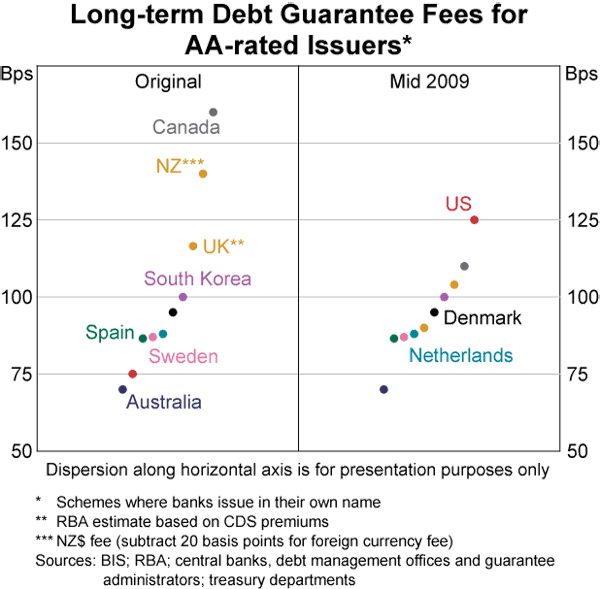
In setting the guarantee fees, the Government and Council of Financial Regulators considered a range of factors, including international settings, pricing for risk, and the need to ensure that the arrangements did not continue indefinitely. The fees were set at a level between the then-current risk spreads – the product of highly stressed conditions – and spreads likely to prevail in more normal market conditions. This was designed to act as a natural exit mechanism, so that when pricing of risk improved, the yield spread between unguaranteed and guaranteed debt would narrow to below the guarantee fee and it would become cost-effective for issuers to return to unguaranteed issuance.
Use of the Guarantee Scheme
As at January 2010, liabilities covered by the Guarantee Scheme were $166 billion, predominantly comprising long-term wholesale funding (Table 2).[3] The total amounts to 7.5 per cent of total ADI liabilities; the share of the guaranteed wholesale funding component is higher, at around 15 per cent of all wholesale liabilities. Fees payable to date by ADIs using the Guarantee Scheme total $1.2 billion, with fees currently running at around $0.1 billion per month.
| $billion | Per cent(a) | |
|---|---|---|
| Large deposits | 12.7 | 1.1 |
| Wholesale funding | 153.6 | 14.7 |
| of which: | ||
| Short-term(b) | 17.1 | |
| Long-term | 136.5 | |
| Total | 166.4 | 7.5 |
|
(a) Large deposits expressed as a share of total ADI deposit liabilities
as at 31 December 2009. Wholesale funding expressed as a share
of total ADI wholesale funding liabilities as at 31 December 2009.
Source: Government Guarantee Administrator |
||
The strongest growth in use of the Guarantee Scheme was in the months around its introduction, when uncertainty was very high. One indication of the take-up of the Guarantee Scheme is in the volume of Eligibility Certificates (certificates) issued by the Reserve Bank, in its role as Scheme Administrator. ADIs require a certificate to access the guarantee, with a separate certificate required for each type of liability. In the case of deposits, a large number of certificates were issued in November and December 2008, reflecting moves by a broad range of institutions to be able to offer the large deposit guarantee over customer accounts at an early stage (Graph 3 and Table 3). Once this ability had been established, there was little subsequent demand. Applications for certificates applying to wholesale liabilities – particularly long-term liabilities – were relatively less bunched towards the Guarantee Scheme's introduction, partly reflecting the narrower range of institutions typically applying for these, and also that the form of the certificates is security-specific.
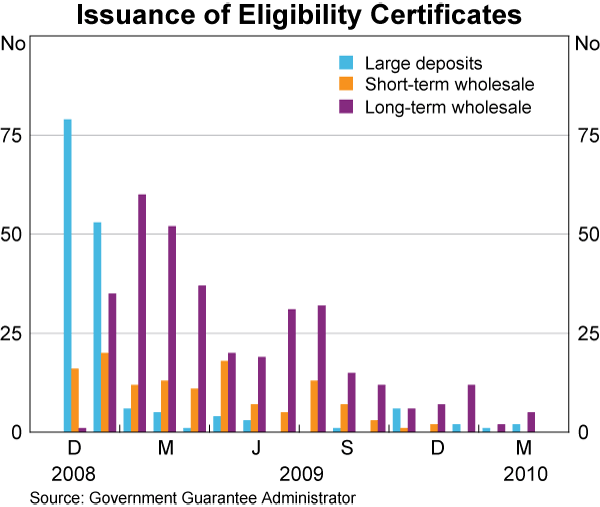
| Type of liability covered | ||||
|---|---|---|---|---|
| Large deposit | Short-term wholesale | Long-term wholesale | Memo: total number of institutions |
|
| Australian-owned banks | 13 | 9 | 9 | 14 |
| Foreign subsidiary banks | 8 | 6 | 4 | 9 |
| Branches of foreign banks | 10 | 9 | na | 34 |
| Credit unions, building societies and other ADIs | 97 | 1 | 1 | 123 |
| Total | 128 | 25 | 14 | 180 |
|
Source: Government Guarantee Administrator |
||||
Growth in the amounts guaranteed under the Guarantee Scheme also shows a tapering off as the extreme dislocation in financial markets has eased. The value of large deposits covered under the Scheme peaked in April 2009 at $24 billion and by January 2010 had fallen below $13 billion (Graph 4). Early use of the Guarantee Scheme for large deposits was encouraged by the pricing practices of a number of ADIs that were absorbing all or some of the guarantee fee to attract or retain customers. However, as concerns about the global financial system eased, ADIs became less willing to absorb the fee, and customers similarly became less inclined to pay for the additional security over what was already a low-risk investment. Although the bulk of ADIs have at least one certificate to offer guaranteed large deposits to their customers, only one-quarter of these institutions had a non-zero balance in January 2010. The value of deposits covered under the Guarantee Scheme amounts to only around 1 per cent of total deposits.
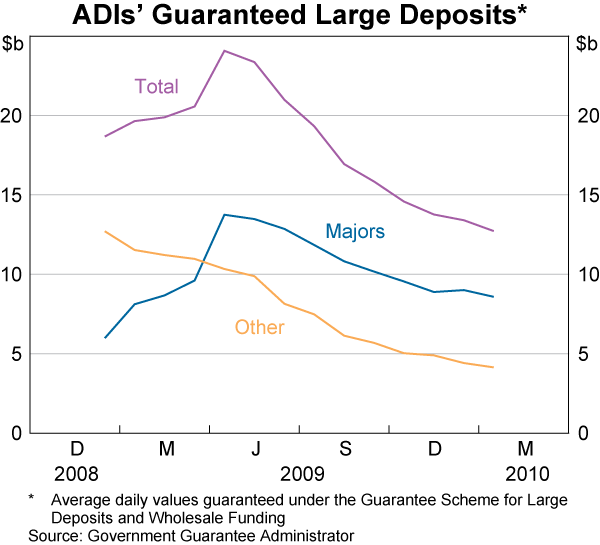
A similar fall in use, though less pronounced, is evident in the value of guaranteed short-term wholesale liabilities (Graph 5). After peaking in February 2009 at $22.4 billion, guaranteed short-term wholesale funding has fallen to average $17.1 billion in January 2010. The decline is significantly greater when looking solely at the Australian banks. Among other institutions, use of the guarantee by foreign branches has increased since May 2009, after the Government increased the maturity limit for them from the original fixed date of 31 December 2009 to a rolling 15 months. The increase was consistent with moves in a number of countries extending guarantee arrangements and maturity limits beyond those initially announced.
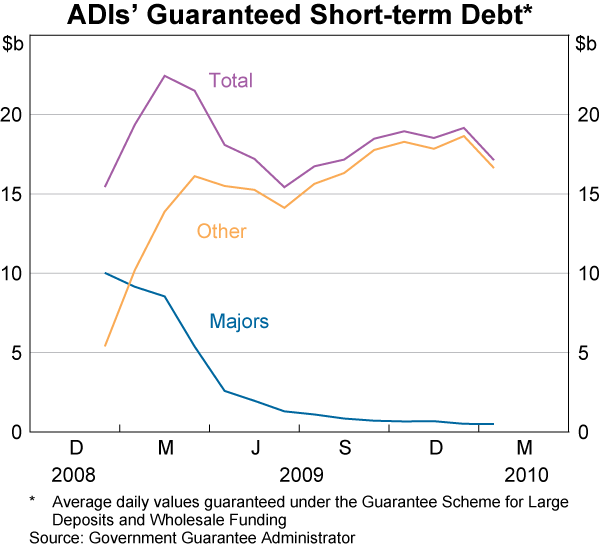
The Guarantee Scheme has predominantly been used to guarantee long-term liabilities. With extreme risk aversion prevailing in global financial markets, ADIs' access to funding through long-term bond issuance was heavily curtailed in the period between the collapse of Lehman Brothers and the Guarantee Scheme's implementation, particularly in offshore markets (Graph 6).[4] In the early months of the Guarantee Scheme, there was heavy issuance of guaranteed bonds as ADIs sought to lengthen the maturity structure of their liabilities. Overall issuance volumes were strong relative to recent history for the system as a whole and, in particular, for lower-rated banks, partially reflecting that the guarantee enabled access to new groups of investors with a mandate for AAA-rated securities.
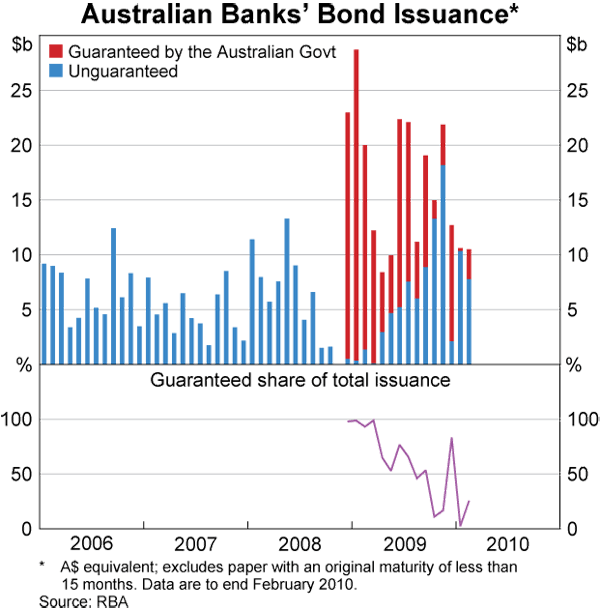
The extreme market conditions gradually eased and by the June quarter 2009 investors were again purchasing a considerable volume of unguaranteed bonds. The share of bond issuance that is guaranteed has fairly steadily decreased with the improving conditions; after accounting for almost all issuance in the months following the Guarantee Scheme's introduction, in the early part of 2010 the share had fallen to close to zero. This reflects that the sharp compression in bank bond spreads over 2009 was more pronounced for unguaranteed bonds than for guaranteed bonds, particularly for higher-rated issuers. As a result, it is now generally advantageous for the AA-rated banks to issue unguaranteed rather than issuing guaranteed and incurring the associated fee.
For lower-rated ADIs, there continues to be little unguaranteed bond issuance. However, these institutions have traditionally not been large issuers in the bond market. In the past, many lower-rated institutions have made more use of the residential mortgage-backed securities (RMBS) market for funding, and this market has shown signs of improvement in recent months.[5] Since the announcement on 7 February 2010 that the Guarantee Scheme will soon close to new borrowing, guaranteed bond issuance from lower-rated banks has picked up from the pace of recent months.
The overall pattern of lower guaranteed bond issuance relative to early in 2009 is also evident in use of guarantee schemes in other countries (Graph 7). In addition to declining risk spreads making unguaranteed debt issuance more attractive, subdued guaranteed issuance also reflects that, in many countries, banks' overall requirements for new debt are not high, as both they and their customers are focused on repairing their balance sheets. In a number of countries, alternative funding sources are also being tapped; for example, European banks have issued heavily into the covered bond market, a market that has been supported by purchases from the European Central Bank.
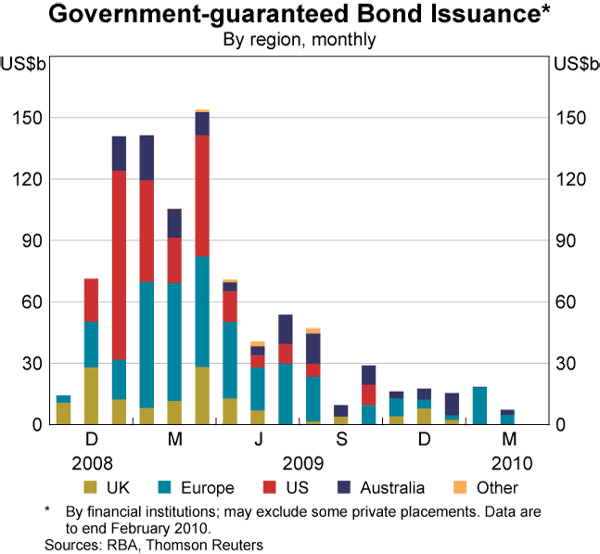
Closure of the Guarantee Scheme
In establishing the Guarantee Scheme, the Australian Government had announced that it would remain open until markets normalise. In comparison, most other countries nominated a fixed date by which debt had to be issued. Given the continuation of difficult conditions, however, these countries typically extended the cut-off date, often on a number of occasions.
The question of when to close such arrangements requires a trade-off of different considerations. Countries have had to weigh the risks of premature closure against the longer-term costs of an extended period of government support. The Council of Financial Regulators, which has been advising the Australian Government on the Guarantee Scheme, recently recommended the closure of the arrangements. On 7 February 2010, the Government announced that the Guarantee Scheme would close to new borrowing from 31 March 2010.
A key consideration behind the Council's advice was that conditions had improved to the point where the Guarantee Scheme is no longer needed. Bank funding conditions are much improved on those prevailing at the time the arrangements were introduced, and recent use of the Guarantee Scheme appears to be largely a response to small pricing advantages rather than reflecting problems of market access. The Council also considered that there are strong grounds for the Guarantee Scheme not to remain in place for a significantly longer period than in most other countries. A number of countries have now closed their schemes: the United States, Canada, France, Korea and the United Kingdom (Table 4). Market sentiment has, to date, been resilient to the scheme closures that have occurred.
| Country | Date |
|---|---|
| United States | 31-Oct-09 |
| Canada | 31-Dec-09 |
| France | 31-Dec-09 |
| South Korea | 31-Dec-09 |
| United Kingdom | 28-Feb-10 |
| Australia | 31-Mar-10 |
| Sweden | 30-Apr-10 |
| Denmark(b) | 30-Jun-10 |
| Finland | 30-Jun-10 |
| Germany(b) | 30-Jun-10 |
| Ireland(c) | 01-Jun-10 |
| Netherlands | 30-Jun-10 |
| Spain(d) | Jun-10 |
| Belgium | 31-Oct-10 |
| New Zealand | Unspecified |
|
(a) Selected countries
Sources: BIS; central banks; debt management offices and guarantee administrators; treasury departments |
|
In contrast, in December 2009, a number of countries in Europe gained European Commission (EC) approval to extend their schemes past the previously announced closure date. Banking systems in this region were more affected by the financial crisis than in Australia, and the guaranteed debt maturities of their banking systems are relatively concentrated in the next few years, given that under most European guarantee schemes, eligible bond maturities were limited to two to three years. For Australian banks, with guaranteed issuance permitted out to five-year maturities, the overall bond maturity profile drawn from market data suggests that refinancing needs for guaranteed debt are relatively well distributed (Graph 8).
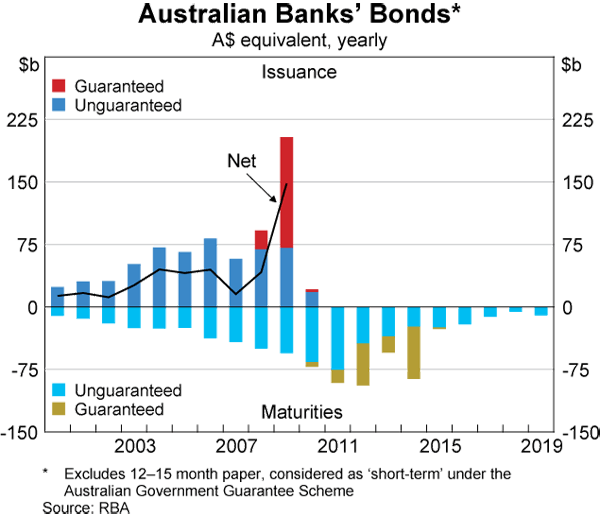
The Guarantee Scheme rules have been amended to give effect to the closure. Eligible institutions have until 24 March 2010 to apply for new certificates, and can issue guaranteed liabilities or create new guaranteed deposits in the period up to and including 31 March 2010. After that date, no further guaranteed wholesale liabilities or term deposits can be issued, although liabilities of these types already covered under the Guarantee Scheme will remain guaranteed until either they mature or are bought back and extinguished by the issuer. At-call deposits covered by the Guarantee Scheme on 31 March 2010 will continue to be covered until the Guarantee Scheme formally winds up in 2015, though depositors will not be able to increase the guaranteed amount above their closing balance on 31 March 2010. Fees will continue to be payable on amounts guaranteed, with the Treasurer indicating that total fees over the life of the Guarantee Scheme, absent early repayments, are likely to be around $5.5 billion.
The closure of the Guarantee Scheme does not affect the Financial Claims Scheme, under which deposit balances totalling up to and including $1 million per customer per institution are guaranteed without charge. These arrangements are scheduled to remain in place until October 2011.Enhanced depositor protection is intended to be a permanent feature of the Australian financial system, although the Government has committed to review parameters such as the $1 million cap in October 2011.
Conclusion
The Guarantee Scheme was introduced in October 2008 in response to extraordinary developments in the global financial system. It has made a positive and important contribution to the stability of the Australian financial system by ensuring that institutions continued to have access to capital markets during the most intense phase of the crisis. The arrangements have also ensured that the overall availability of funding has not been a material constraint on the capacity of Australian banks to lend and, for a time, served to mitigate the large increase in the cost of issuing debt. However, market conditions have significantly improved, and similar arrangements in a number of other countries have been closed. Accordingly, the Government, on the advice of the Council of Financial Regulators, has announced that the Guarantee Scheme will close to new borrowing from end March 2010.
Footnotes
The author is from Financial Stability Department. [*]
For more detail on the introduction of the Financial Claims Scheme and changes in deposit protection internationally, see RBA and APRA (2009). [1]
Foreign branches have had restricted access to the Guarantee Scheme including a shorter maturity limit (initially out to 31 December 2009, and subsequently amended to a rolling 15-month maturity). The differing treatment reflects that, unlike the foreign bank subsidiaries, foreign bank branches are not separate entities incorporated and independently capitalised in Australia – they are part of the foreign bank incorporated overseas. [2]
Data on liabilities covered by the Guarantee Scheme are updated monthly at <http://www.guaranteescheme.gov.au/liabilities/summary-info.html>. [3]
For more discussion on banks' bond issuance through this period see Black, Brassil and Hack (2010). [4]
For more detail on developments in RMBS markets, and funding markets generally, see Brown et al (2010). [5]
References
Black S, A Brassil and M Hack (2010), ‘Recent Trends in Australian Banks' Bond Issuance’, RBA Bulletin, March, pp 27–33.
Brown A, M Davies, D Fabbro and T Hanrick (2010), ‘Recent Developments in Banks' Funding Costs and Lending Rates’, RBA Bulletin, March, pp 35–44.
RBA and APRA (2009), ‘Joint Submission to the Inquiry by the Senate Economics References Committee into Bank Funding Guarantees’, 24 July.